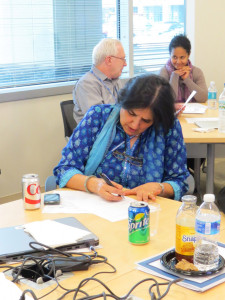How Many Partners Does it Take to Run The DHS Program?
Most people don’t know just how many collaborating institutions are involved in the day-to-day implementation of The DHS Program. ICF International is the prime contractor for The DHS Program. But 20% of us who sit at ICF’s office in Rockville, Maryland, are actually employed by other partner organizations. Who are these partners?
- Avenir Health (formerly the Futures Institute) specializes in data analysis for decision making and planning. Avenir Health staff are key to The DHS Program analysis team.
- Blue Raster is our web and GIS partner. They are instrumental in the development of the website, STATcompiler, mobile app, and API, and support mapping activities at The DHS Program.
- EnCompass is our partner on capacity strengthening. They bring expertise in adult learning, elearning, building institutional capacity, and curriculum design.
- Johns Hopkins University School of Public Health/Center for Communication Programs brings a long history of communicating and disseminating complex health information to a wide range of audiences.
- Kimetrica is our only partner based in Africa, and supports DHS survey data processing and survey implementation.
- PATH brings expertise in innovation in improving global health through their support of The DHS Program’s nutrition, laboratory and biomarker work.
- Vysnova Partners provides technical services in many areas of global health. For The DHS Program, Vysnova provides staff with data processing and survey management skills.
Twice a year, staff from all 8 institutions and members of The DHS Program’s USAID management team sit together for a day of information sharing. This spring’s “The DHS Program Partners’ Meeting” featured presentations on updates to the DHS-7 questionnaire, methodological research on data quality in DHS surveys, results from a study on nutrition and WASH indicators, results from the 2013-14 Malawi SPA survey, an update on recent training workshops, and the “world premiere” of the newest DHS Program tutorial YouTube video on the contraceptive prevalence rate. Several DHS survey managers provided personal perspectives on how Ebola affected survey operations in Liberia, Guinea, Sierra Leone, and Nigeria. In addition, partners participated in hands-on activities on social media, data visualization, and mapping.
The participants summed up everyone’s sentiments quite well with the tweets they proposed in the social media session:

Sunita Kishor, DHS Program Director, drafts a Tweet in the social media session. #DHSpartners #SunitasFamily
Dance with us @DHSprogram. We have great partners. #DHSpartners
Partnering to bring data & knowledge to YOU! #dataispower #DHSpartners #usedata
#DHSpartners’ family reunion today #SunitasFamily
@ICFI and #DHSpartners shine @DHSprogram.
Who ya gonna call? @DHSprogram! #DHSpartners #SunitasFamily #DataDrivesDecisions
@DHSprogram brings together #DHSpartners for knowledge sharing & innovation.





